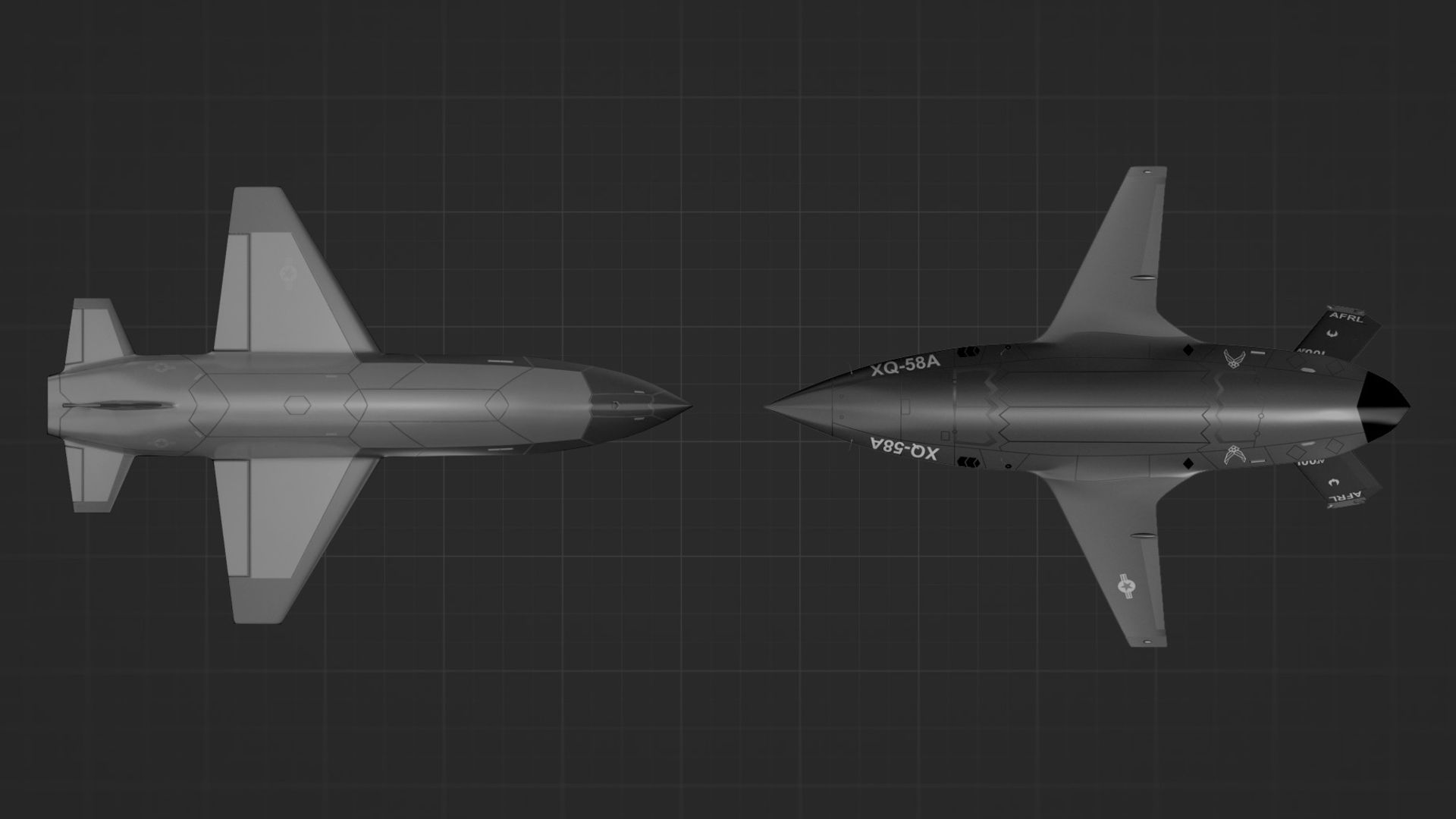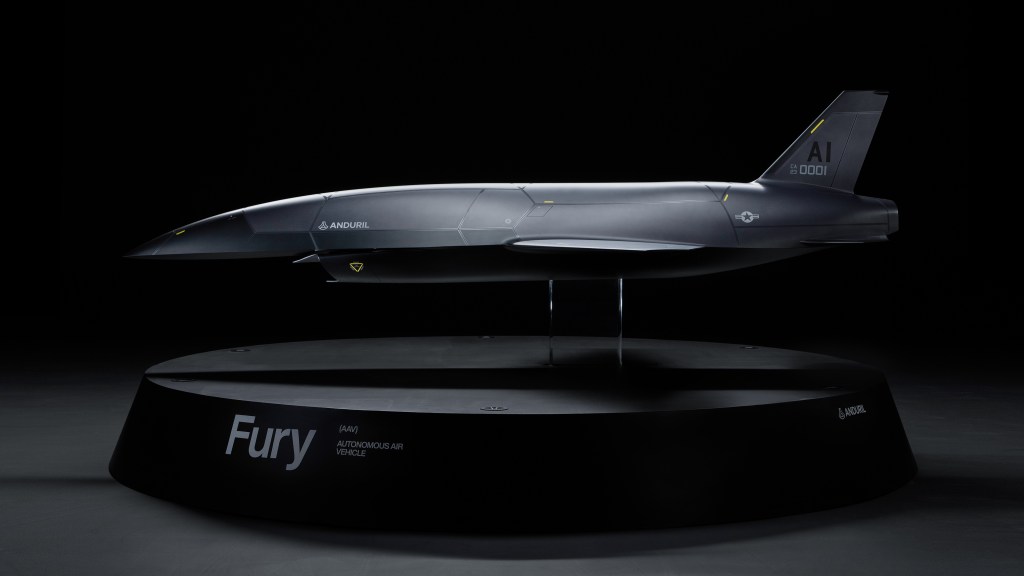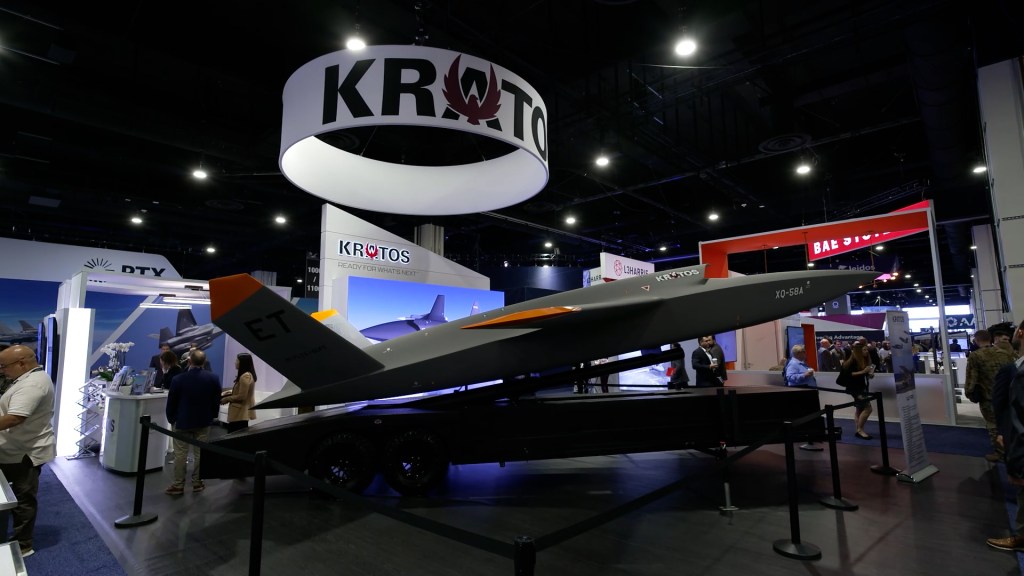
ONE CREW, ONE CRAFT. FOR DECADES, THAT’S BEEN THE PARADIGM OF AIR COMBAT, BUT THE PARADIGM IS SHIFTING. IN FUTURE FIGHTS THE PILOTS WILL BE FACING SOME OF THE FIERCEST SKIES THEY’VE EVER SEEN. SO, THE AIR FORCE IS TRYING TO HELP OUT ITS PILOTS BY CREATING MORE CREWLESS CRAFT, LIKE THIS FURY.
Van Timmerman: So, Fury is a conventional takeoff and landing aircraft. We are looking to use as minimal runway as possible to provide the maximum amount of options for all of our areas that we may want to fly.
ANDREW VAN TIMMERMAN, CALLSIGN SCAR, IS A RETIRED AIR FORCE FIGHTER PILOT AND CURRENT DIRECTOR OF AIR DOMINANCE SYSTEMS AT ANDURIL.
THE COMPANY WAS ONE OF NEARLY 200 VENDORS AT THE AIR AND SPACE FORCES ASSOCIATION’S AIR, SPACE AND CYBER 2023 CONFERENCE IN NATIONAL HARBOR, MARYLAND.
IN ADDITION TO THE ½ SCALE MODEL FURY ON DISPLAY, KRATOS HAD A FULL-SIZE MODEL OF ITS XQ-58 VALKYRIE.
Otis Winkler: So really, it is a fighter-like performance. If you want to think of it as an F-35 without a pilot in it, that’s what you’ve got. It’s got a bomb bay, you’ve got weapons on the wingtips, or on the wings themselves. Take that fight to the enemy if they need to.
BOTH THE FURY AND THE VALKYRIE ARE CANDIDATES IN THE US MILITARY’S COLLABORATIVE COMBAT AIRCRAFT, OR CCA, PROGRAM. THE GOAL IS TO CREATE THOUSANDS OF HIGHLY CAPABLE ROBOTIC WINGMEN QUICKLY, AND DO IT ALL FOR A FRACTION OF THE COST OF TRADITIONAL FIGHTER JETS. THE PRICE OF A NEW F-35 IS WELL NORTH OF $100 MILLION.
General White: We’ve kept continuous competition across the mission systems, across the autonomy space, as well as across the air vehicle space.
BRIG GENERAL DALE WHITE IS THE PROGRAM EXECUTIVE OFFICER FOR FIGHTERS AND ADVANCED AIRCRAFT FOR THE AIR FORCE. IT’S HIS JOB TO MAKE SURE THE CCA PROGRAM IS A SUCCESS.
General White: By the way, if you look around when you walk the floor at AFA, I think it’s pretty clear to see there’s a wide variation between vehicles, sizes, weights, and things of that nature.
VARIATIONS IN THE DESIGN OFTEN EQUATE TO VARIATIONS IN FIELDING AS WELL. SO, LET’S TAKE A LOOK AT JUST HOW THE FURY AND THE VALKYRIE STACK UP.
FOR STARTERS, FURY IS STILL UNDER DEVELOPMENT WHILE THE VALKYRIE WAS THE FIRST, AND AS OF THE PUBLISHING OF THIS VIDEO, STILL ONLY CCA CANDIDATE FLYING IN THE REAL WORLD.
Otis Winkler: It is awesome. It’s changing the game right now, with the Air Force and with the Marine Corps. This is the way that you get more mass to the fight. It’s survivable and it’s ready today.
JUST BECAUSE FURY HASN’T FLOWN, THOUGH, DOESN’T MEAN ITS DESIGNERS DON’T HAVE BIG PLANS FOR IT. FURY WILL STILL DELIVER FIGHTER LIKE PERFORMANCE, AND IT WILL DO SO WITH A SINGLE, COMMERCIALLY AVAILABLE JET ENGINE. THAT HELPS MAKE MAINTENANCE EASIER AND KEEPS COSTS DOWN.
THE FURY AND VALKYRIE BOTH ADHERE TO THE DOD’S OPEN-ARCHITECTURE MANDATE. SO, THEY CAN BE KITTED OUT WITH ALL SORTS OF DIFFERENT TECH DEPENDING ON THE MISSION.
Van Timmerman: So, that could include radar, jamming. It could be IR. It really is anything that you have that’s available on an existing aircraft. We want to be able to provide as much plug and play utility out of the vehicle so that we can, again, provide those different mission sets to whatever the commander needs of that day.
AS WE HEARD EARLIER, FURY WILL NEED A RUNWAY TO TAKE OFF AND LAND, ALBEIT A MUCH SHORTER RUNWAY. THE VALKYRIE USES A TURBO-FAN ENGINE TO LAUNCH OFF THE BACK OF A TRAILER. IT CAN BE RECOVERED UNDER A PARACHUTE ONCE THE MISSION IS OVER.
Otis Winkler: So, you can put these anywhere. We normally put them in a shipping container. Take the wings off, put it in the back of a shipping container. It’s all self-contained. You drop it either near the rest of the runway, or you can drop it in a forward operating base somewhere. Open it up with two men, slide out the rail, put the wings on with a couple of bolts, and then it launches with all the weapons on it.
THE VALKYRIE CAN CARRY UP TO FOUR SMALL DIAMETER BOMBS OR SIMILAR SIZED MUNITIONS IN ITS BOMB BAY. IT’S WING STATIONS CAN ALSO HOLD LETHAL PAYLOADS.
FURY WON’T CARRY KINETIC WEAPONS. AS SCAR MENTIONED EARLIER, ITS PAYLOAD IS PRIMARILY A SUITE OF SENSORS AND ELECTRONIC WARFARE SYSTEMS.
FURY AND VALKYRIE–LIKE ALL CCA CANDIDATES– WILL BE PILOTED BY ARTIFICIAL INTELLIGENCE. ANDURIL USES ITS LATTICE FOR MISSION AUTONOMY SOFTWARE. THE COMPANY HAS BEEN PERFECTING THE TECHNOLOGY FOR SEVERAL YEARS NOW, INCLUDING IN THE AIR FORCE’S PROJECT VENOM INITIATIVE, WHICH PUTS AI-AGENTS IN CHARGE OF MODIFIED F-16s WHILE HUMAN PILOTS ESSENTIALLY OBSERVE IN THE COCKPIT.
IN LATE SEPTEMBER, KRATOS AND SHIELD AI ANNOUNCED THE TWO COMPANIES WILL COLLABORATE TO PUT SHIELD AI’S HIVEMIND INTO THE VALKYRIE. I’VE REPORTED BEFORE ON HIVEMIND, WHICH IS TOUTED AS THE WORLD’S BEST AI PILOT.
CCAs MAY NOT HAVE HUMAN PILOTS, BUT REST ASSURED, HUMANS WILL STILL BE GIVING THE ORDERS.
Van Timmerman: I think what we really can use these air vehicles for is we can have somebody remove themselves from inside of the loop and go on to the loop. What do I mean by that? When you are inside the loop, think about a man or woman, a person inside the cockpit. They’re in charge of the stick, and the throttle and every decision that’s made inside the aircraft. When you go onto the loop, you have one person that could be in charge of maybe many of these air vehicles, and they may have sensors, they may just be flying around to draw attention. There are a number of different use cases you can have in an advanced autonomy enabled system.
WHILE THE AIR FORCE WANTS TO EVENTUALLY SELECT A SINGLE CONTRACTOR TO BUILD ITS COLLABORATIVE COMBAT AIRCRAFT, BECAUSE OF THE OPEN ARCHITECTURE NATURE OF THE DESIGN PROCESS, THE FINAL CRAFT MAY CONTAIN COMPONENTS AND KIT FROM SEVERAL DIFFERENT SUPPLIERS.
WE SHOULDN’T HAVE TO WAIT TOO LONG EITHER TO FIND OUT WHO THOSE SUPPLIERS ARE. THE PENTAGON WANTS THE CCAs AIRBORNE BY 2027, WHEN SOME THINK CHINA MAY INVADE TAIWAN.









